翻译研究:探索与思考(周红民 著)思维导图
- 格式:xmin
- 大小:5.28 KB
- 文档页数:1
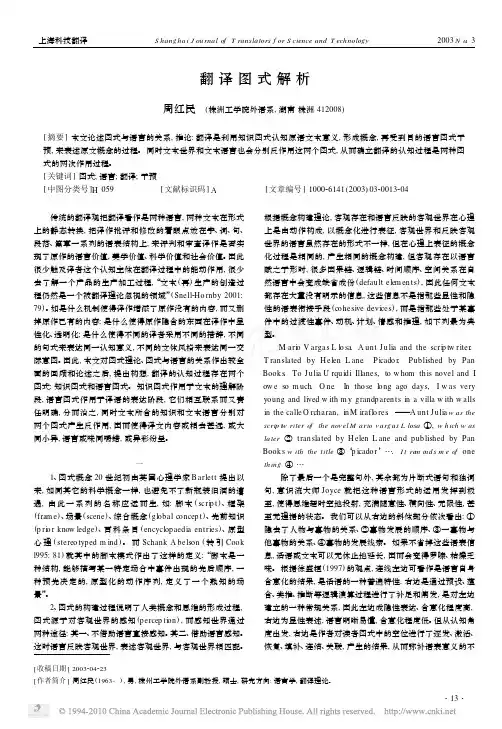
上海科技翻译S hang hai J ou rnal of T ranslators f or S cience and T echnology 2003N o .3[收稿日期]2003204223[作者简介]周红民(1963-),男,株州工学院外语系副教授,硕士,研究方向:语言学,翻译理论。
翻译图式解析周红民 (株洲工学院外语系,湖南株洲412008)[摘要]本文论述图式与语言的关系,推论:翻译是利用知识图式认知原语文本意义,形成概念,再受到目的语言图式干预,来表述原文概念的过程。
同时文本世界和文本语言也会分别反作用这两个图式,从而确立翻译的认知过程是两种图式的两次作用过程。
[关键词]图式;语言;翻译;干预[中图分类号]H 059[文献标识码]A[文章编号]100026141(2003)0320013204 传统的翻译观把翻译看作是两种语言,两种文本在形式上的静态转换,把译作批评和修改的着眼点放在字、词、句、段落、篇章一系列的语表结构上,来评判和审查译作是否实现了原作的语言价值,美学价值、科学价值和社会价值。
因此很少触及译者这个认知主体在翻译过程中的能动作用,很少去了解一个产品的生产加工过程,“文本(再)生产的创造过程仍然是一个被翻译理论忽视的领域”(Snell 2Ho rnby 2001:79)。
如是什么机制使得译作增添了原作没有的内容,而又删掉原作已有的内容;是什么使得原作隐含的东西在译作中显性化、透明化;是什么使得不同的译者采用不同的措辞,不同的句式来表达同一认知意义,不同的文体风格来表达同一交际意图。
因此,本文对图式理论、图式与语言的关系作出较全面的回顾和论述之后,提出构想,翻译的认知过程存在两个图式:知识图式和语言图式。
知识图式作用于文本的理解阶段,语言图式作用于译语的表达阶段,它们相互联系而又责任明确,分而治之,同时文本所含的知识和文本语言分别对两个图式产生反作用,因而使得译文内容或相去甚远,或大同小异,语言或味同嚼蜡,或异彩纷呈。
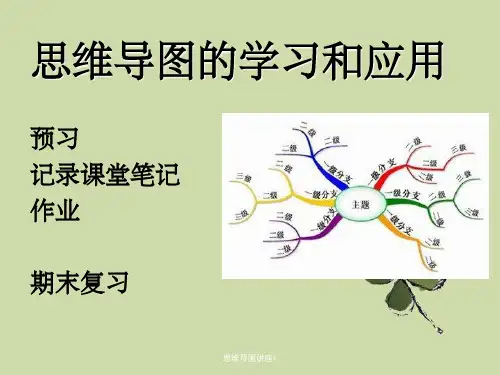
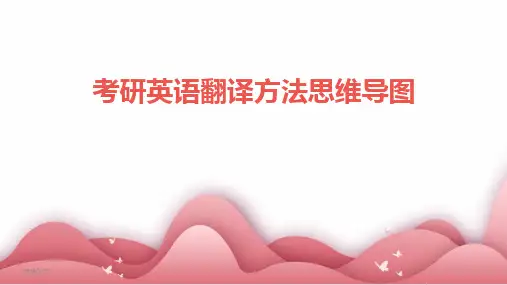
考研英语翻译方法思维导图CONTENTS •introduction•Overview of English Translation Methods for Postgraduate Entrance Examination•The application of mind mapping in English translation forCONTENTS•Common errors and avoidance methods in English translation for postgraduate entrance exams•Practical Practice and Analysis of English Translation forintroduction01Cultivate translation thinking: Through learning and training, cultivate candidates' translationthinking, improve their sensitivity and expression ability to the English language.Improve the English translation ability of the postgraduate entrance examination: By learningand practicing various translation methods, improve the scoring ability of candidates in the English translation section of the postgraduate entrance examination.Response to exam requirements: Provide effective preparation strategies and methods for theEnglish translation section of the postgraduate entranceexamination, based on the exam requirements and scoring standards.Purpose and backgroundApplicable scopeGraduate English Exam CandidatesSuitable for all candidates taking the postgraduate English exam, especiallythose who need to achieve high scores in the translation section.English learnersIt also has certain reference value for English learners who hope to improve theirEnglish translation ability and language proficiency.Translation practitionersFor those engaged in translation work, practical translation methods and skillscan be provided to help them better complete translation tasks.Overview of English Translation Methods for Postgraduate Entrance02Literal translation methodWord translationPreserve the original words in the translation without violating the language norms of the original textand without causing erroneous associations.Structural transformationWhen the structure of English sentences is inconsistent with that of Chinese sentences, structuraltransformation is required to make the translation conform to Chinese expression habits.Omitting and supplementingAccording to Chinese expression habits, omit or supplement some redundant or missinginformation in the original text.Free translation methodWhen translating, pay attention to the fluency and readability of the translation to make it conform to Chinese expression habits.Keep the translation fluentWhen translating, the first step is to understand the deep meaning of the original text and the author's true intention.Understanding the meaning of the original textdon't stick to the words and structures of the original text, use words andstructures that conform to Chinese expression habits to express the original meaning.Get rid of the original formPersonal names, place names, brand names, and other proprietary terms: For such vocabulary, transliteration is generally used to express the original pronunciation in similar Chinese Some common vocabulary: In some cases, transliteration can also be used to enhance the readability and interest of the translation.Abbreviations and abbreviations: For suchvocabulary, transliteration can also be used toexpress the original pronunciation incorresponding Chinese characters. transliterationWhen translating, retain the image metaphors and rhetorical devices in the original text to make the translation more vivid and vivid.When the image in the originaltext cannot find a correspondingexpression in Chinese, themethod of image conversion canbe used to express the originalmeaning with an image thatconforms to Chinese expressionhabits.In some cases, in order to betterexpress the original meaning andenhance the expressive power ofthe translation, new imagemetaphors and rhetorical devicescan be created.Preserve the original image Image conversion Creating newimagesForm translation methodThe application of mind mapping in English translation for postgraduate03•Definition: A mind map is a graphical thinking tool that visualizes complex information and thinking processes through elements such as graphics, lines, and colors.characteristicVisualization: Using elements such as graphics and colors to make information more intuitive and easy to understand.Flexibility: Mind maps can be adjusted in structure and content as needed, making it easy for users to modify and improve. Structured: A mind map focuses on the central theme and radiates multiple sub themes outward, forming a clear hierarchical structure.Improving translation efficiency By using mind maps, one canquickly organize the structure of an article, locate key information, and improve translation speed and accuracy.要点一要点二Enhanced memoryeffectMind maps visualize important information and key points during the translation process, helping to deepen memory.Developing logical thinkingThe hierarchical structure of mind maps helps to cultivate the logical thinking ability of translators, making translation more accurate and fluent.要点三The advantages of mind mapping in translating English for postgraduate entrance examsHow to use mind maps to translate English for postgraduate entrance exams•Preparation: Familiarize oneself with the topic and backgroundknowledge of the article, understand relevant vocabulary andexpressions.•Create a mind map: Determine the central theme, which is the title orcore content of the article to be translated, and radiate multiple subthemes outward, including article structure, key information, importantvocabulary, etc.•Improve mind map: Gradually fill in each part of the mind mapaccording to the content of the article, add detailed information andrelated examples to make the mind map more rich and complete.•Using mind maps for translation: Based on the hierarchical structureand information prompts of mind maps, gradually translate to ensureaccuracy and fluency. At the same time, the mind map can be adjustedand improved at any time to adapt to changes in the translationprocess.Translation skills and strategies for postgraduate entrance examination04Carefully read the original text andunderstand the main idea and paragraphs of the article.Pay attention to the contextual meaning of vocabulary and avoid misinterpretation.Analyze sentence structure and grasp thelogical relationship between sentences.Understand the language styles of different literary genres, such as technology, literature,business, etc.9字9字9字9字Understand the original meaning and grasp the language styleChoose appropriate vocabulary and phrases to accurately express the original meaning.Use various sentence structures to make the translation more natural and fluent in expression.Pay attention to the collocation and usage of vocabulary, and avoid Chinglish.Maintain the coherence and consistency of the translation to avoid contradictions or repetition.Pay attention to selecting words and sentences, and maintain language fluency0102Omitting methodOmitting redundant or unnecessary information from the original text.Additional …Add necessaryvocabulary or phrases tomake the translationmore complete.TranslationmethodTransformingvocabulary or phrasesfrom the original textinto another form ofexpression.TranslationmethodSplit long sentencesinto multiple shortsentences to make thetranslation clearer andeasier to understand.Comprehensivemethodcomprehensively applythe above techniques tomake the translationmore accurate, fluent,and natural.030405Mastering translation skills to improve translation efficiencyCommon errors and avoidance methods in English translation for 0501 02 03Vocabulary errorsincluding confusion of word meanings, improper vocabulary combinations, etc.Grammar errorserrors in tense, voice, subject verb consistency, etc.Lack of cultural background knowledgeTranslation errors caused by lack of understanding of relevant cultural backgrounds.Common types of errorsError Cause AnalysisLack of solid language foundationInaccurate and proficient mastery of vocabulary and grammar.Lack of cultural background knowledgeInsufficient understanding of the cultural background in the relevant field.Improper translation skills and methodsLack of necessary translation skills and methods, resulting in low translationquality.Strengthen language basic training: improve vocabulary and grammar level, and enhance language perception ability.Expand culturalbackground knowledge:Widely read variousEnglish original works,newspapers andmagazines, etc., andaccumulate knowledge inrelated fields.Mastering translationskills and methods: Learnand master varioustranslation skills andmethods, such asaddition translation,omission translation,conversion method, etc.,to improve translationaccuracy and fluency.Do more practice andsimulation tests: Throughextensive practice andsimulation tests, improvetranslation speed andaccuracy, cultivatetranslation thinking andadaptability.Discussion on Avoidance MethodsPractical Practice and Analysis ofEnglish Translation for06•Review and Analysis of 2022 True QuestionsTitle OverviewTranslation difficulties and techniques Reference translation and rating•Review and Analysis of 2021 True QuestionsTitle OverviewTranslation difficulties and techniques Reference translation and rating•Trend analysis of past real test questionsReview and Analysis of Historical True Questions Change in question typeDistribution of examinationpointsDifficulty changesSimulated Question 1 Topic displayTranslation ideas guidance•Reference translation and self-evaluationSimulated Question 2Topic display Translation ideas guidance•Reference translation and self-evaluation•Simulated question threeTopic displayTranslation ideas guidanceReference translation and self-evaluationWord Meaning Selection Techniques Determine word meaning based on contextPay attention to the phenomenon of polysemy in a wordSentence structureanalysis techniquesIdentifyingsentencebackbone andmodifying Strategies for handling complex sentence patternsSkills for applying cultural background knowledge Understanding the culturaldifferences between Chinaand the WestProperly applyingbackground knowledge toassist translation谢谢您的聆听THANKS2024/1/2541。
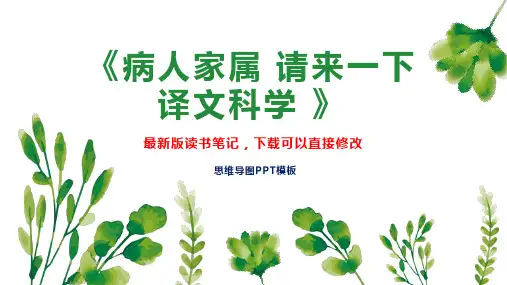
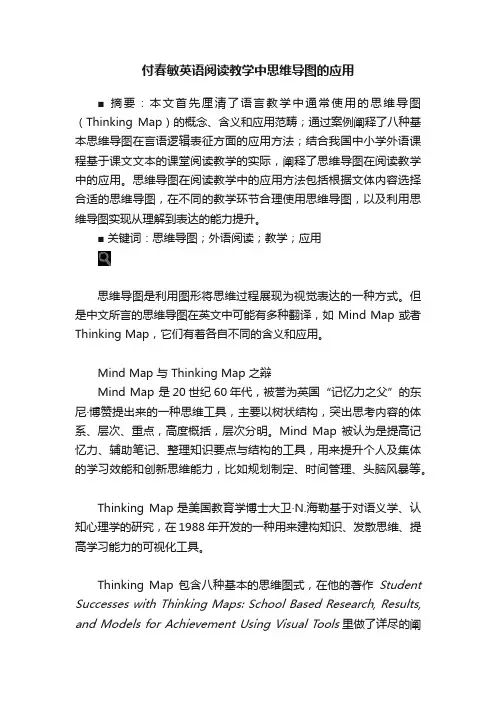
付春敏英语阅读教学中思维导图的应用■ 摘要:本文首先厘清了语言教学中通常使用的思维导图(Thinking Map)的概念、含义和应用范畴;通过案例阐释了八种基本思维导图在言语逻辑表征方面的应用方法;结合我国中小学外语课程基于课文文本的课堂阅读教学的实际,阐释了思维导图在阅读教学中的应用。
思维导图在阅读教学中的应用方法包括根据文体内容选择合适的思维导图,在不同的教学环节合理使用思维导图,以及利用思维导图实现从理解到表达的能力提升。
■关键词:思维导图;外语阅读;教学;应用思维导图是利用图形将思维过程展现为视觉表达的一种方式。
但是中文所言的思维导图在英文中可能有多种翻译,如 Mind Map 或者Thinking Map,它们有着各自不同的含义和应用。
Mind Map 与 Thinking Map 之辩Mind Map 是20世纪60年代,被誉为英国“记忆力之父”的东尼·博赞提出来的一种思维工具,主要以树状结构,突出思考内容的体系、层次、重点,高度概括,层次分明。
Mind Map 被认为是提高记忆力、辅助笔记、整理知识要点与结构的工具,用来提升个人及集体的学习效能和创新思维能力,比如规划制定、时间管理、头脑风暴等。
Thinking Map 是美国教育学博士大卫·N.海勒基于对语义学、认知心理学的研究,在1988年开发的一种用来建构知识、发散思维、提高学习能力的可视化工具。
Thinking Map 包含八种基本的思维图式,在他的著作Student Successes with Thinking Maps: School Based Research, Results, and Models for Achievement Using Visual Tools 里做了详尽的阐释。
这八种基本的思维图式在美国的中小学教学中被用于引导学生梳理思考路径、厘清要素关系、强化推理过程,如今已经被广泛应用于各个年级、各个学科的教学。
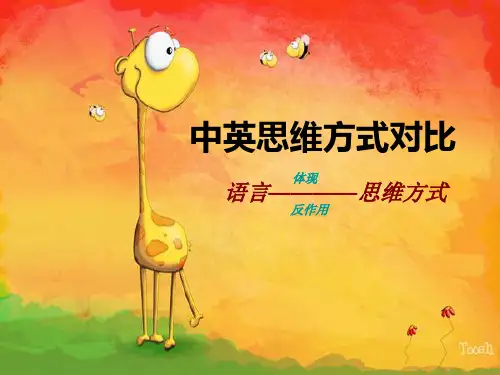
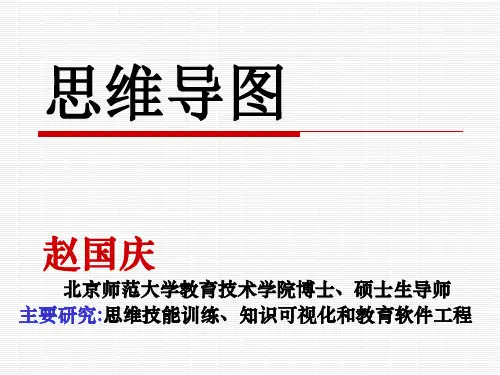
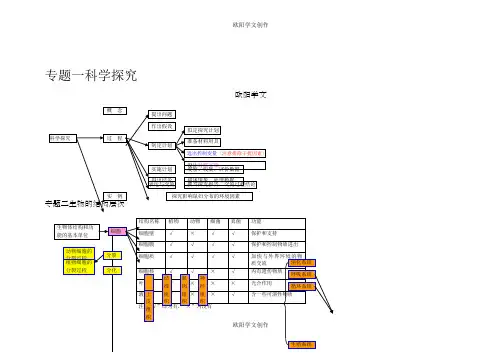
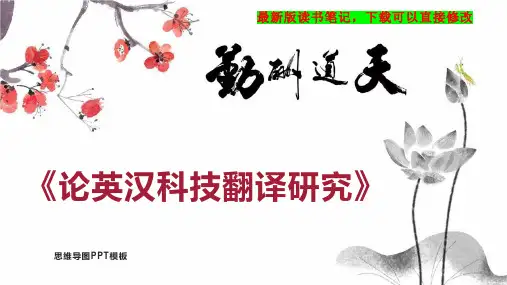
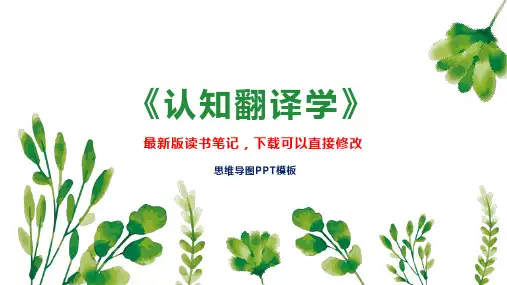
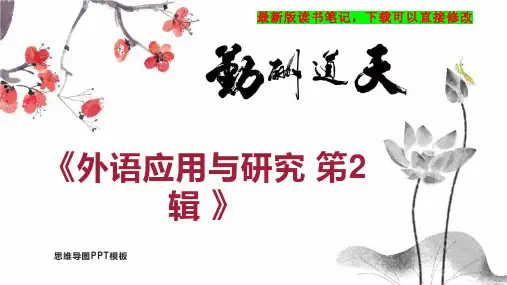
探究思维导图在初中英语读后写作教学中的运用何素兰摘要:在初中英语课标中,对学生的英语写作目标做出了明确的要求,要求学生能根据写作要求收集素材,独立写作,根据图画提示进行描述等。
因此,在初中阶段英语教学过程中,英语教师一般以阅读教学为手段,帮助学生通过模仿文本的表达方式、话题、结构句型、句式等来逐渐掌握基本的英语写作技巧,发展学生的英语写作能力。
关键词:思维导图;初中英语;读后写作;教学在初中英语实际教学中,许多学生存在不会写、不知道怎么写,不知道用什么素材等写作问题。
因此,在对学生的读后写作教学中很有必要引导学生对写作思路、文章结构等进行梳理,其中思维导图的运用可以有效帮助学生将抽象思维过程转化为具体的图像表达,帮助学生筛选、整合信息,提升学生的思维能力、理解能力等,从而有效实现高效的英语读后写作学习。
1思维导图的教学定义及作用思维导图又名心智图,是一种能够有效将人的思维过程形象表达的图形思维工具。
思维导图的运用有效解决了人在记忆过程中短期记忆时间短,记忆内容少的问题,利用关键词、图形、颜色等结合层级图表,并且通过左右脑的相互协调合作帮助人们架起记忆不同内容间的桥梁,从而减少记忆负担,提高人的记忆效率的同时构建一个清晰的思维过程发展人的思维能力。
在初中英语读后写作教学过程中使用思维导图,其形式与传统英语教学方式相比更加有趣高效,能够激发学生学习英语的兴趣;此外,在阅读教学过程中运用思维导图能够帮助学生更好的掌握文本知识、语言结构、理解作者写作思路等,为之后学生的写作教学做好必要的准备;思维导图也能够有效提升学生的记忆效率,同时促进学生思维发展,最终实现学生英语综合能力的发展目标。
2思维导图在初中英语读后写作教学中的运用探究2.1学生写作前思维导图的运用在读后写作的英语教学中,教师要重视在阅读后也就是写作前这一阶段的教学指导。
做好了充足的准备,才能帮助学生在面对将平时积累的语言词汇、句型等转化为文本,对文章进行谋篇布局时更加顺利。
高中英语思维导图提升学生思维品质的探究发布时间:2021-05-14T16:48:15.210Z 来源:《中国教师》2021年第18卷2月第4期作者:明红[导读] 在高中英语教学过程中,教师专注培育学生的英语思维品质是其中重要的教学目标明红濮阳市第一高级中学摘要:在高中英语教学过程中,教师专注培育学生的英语思维品质是其中重要的教学目标,是提升学生英语核心素养的有效手段之一,对学生的英语综合素养发展有至关重要的作用。
在实践教学过程中,教师充分认识到思维导图这一表达方式的重要作用,在英语课堂中挖掘此教育方式的优势应用到不同教学环节中,让学生积极主动去探究英语知识,在此过程中让他们的思维得以深化发展,促使学生的英语综合素养得到内化及巩固。
本文笔者结合自身的教育实践经验,从以下三个方面入手探析如何优化思维导图教学,促使学生思维品质提升。
关键词:思维导图思维品质梳理社会高速发展带来的不仅仅是生活水平的提高,教学新方式的出现也促进了教育的发展,思维导图对于高中生来说,相对已经比较容易理解,可以通过思维导图来激发思维品质,下面是详细措施。
一、采用思维导图明确主题帮助学生归纳知识思维导图在英语教学中是一个常用的有效教学形式,教师在教学过程中采用思维导图辅助教学能够让学生了解不同英语知识间的联系,帮助学生构建完善的知识体系,让学生在对英语知识的多元探索过程中锻炼自己的英语思维,让学生更深入地学习英语知识,对语篇文本内容形成更全面、系统的认知。
在实际教学过程中,教师鼓励学生在学习语篇知识时通过自主阅读将相关内容制作成思维导图的方式厘清知识脉络,在自主绘制思维导图的方式鼓励他们整合知识,强化知识间的联系,在英语知识重难点的梳理过程中提升学生的总结归纳能力。
比如,教师在引导学生学习定语从句这一重要的知识点时,为了让学生内化重点语法知识,教师就可以引导学生构建思维导图,引导其对定语从句中涉及的基本结构、关键词作用及关键词分类进行梳理,在此学习过程中让学生理解此语法知识的内在概念,做好关键词的作用及分类,让学生自主生成系统的记忆网络,如将“定语从句”作为关键词,从定义、组成、关系词、特殊用法等方面梳理,关系词又可以分为代词和副词……同时教师还可以针对定语从句的教学难点,帮助学生在复习的过程中通过分析梳理和出示相应的例句形式让学生去将复杂的繁琐的语法内容变得更有条理化和精细化,让学生能够对相关的内容有系统且全面的认识。